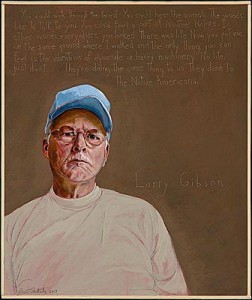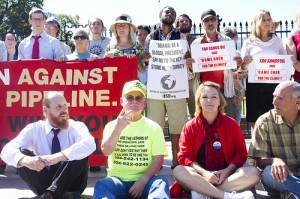
“They tell us we’re collateral damage. Well, I ain’t collateral damage. I am somebody. My name is Larry Gibson.”
–Larry Gibson
Politics in West Virginia always feel more real to me. Energy and economic policies have allowed coal companies to turn the state into a national sacrifice zone. Mountains are flattened by a surface mining technique called mountaintop removal, which buries rivers and streams in debris and poisons the ground water with the waste. Appalachians that fight back or speak out are often ostracized and viciously attacked by pro-coal partisans while officials often look away or side with industry. My friend Larry Gibson lived that reality more than most.
Yesterday, after decades of fighting Big Coal, Larry passed away on Kayford Mountain.
The first time I met Larry was like the first time lots of other people met Larry over the years. It was at his family home on Kayford Mountain. The “family home” was a small, simple house. The 54 acre property is surrounded by one of the largest mine sites in the state. When you look at the mine site from Larry’s property line, you see moonscape. When you look at aerial photos of it, you see an island of green surrounded by moonscape.
Larry had decided early on that he wouldn’t sell out to the coal companies and allow them to strip mine Kayford, a place his family had lived on for generations. Larry spent a lot of his life in the past 20 years traveling the country speaking out powerfully, in his trademark bright yellow hat and t-shirt, about mountaintop removal and the coal industry’s war on Appalachia. He started a foundation called Keepers of the Mountain that has since educated and inspired thousands. Churches, schools, community groups: he never gave up. Larry kept fighting and spreading the gospel about his mountain home until the end.
He was one of the most warmhearted people I knew and had a sweet sense of humor. No one was a stranger to him. He stayed at my house in the Mission district of San Francisco for a few days last year and woke up early every day to go just walk around the neighborhood and talk to people.
Larry once said:
I never wanted to become an activist, but I had to. If I hadn’t I would have been torn off this mountain a long time ago. There are thousands of people around the world who have heard me speak since I started this work, but honestly I wish to God no one knew my name. I wish I didn’t have to leave my home and talk to people about mountaintop removal. Last year I traveled eight months out of the year talking to people about this stuff. But I know I have to bring this message to the world and I’m gonna fight for justice in every way I can. We have to have an uprising. This isn’t an uprising that can be bought with money, but one that’s coming from the hearts of honest and hardworking people.

RAN had a long history with him. The Coal Finance Campaign worked with Larry for years on campaigns to end mountaintop removal. Former RAN Senior Campaigner Annie Sartor remembers working with Larry around the Chase and Bank of America shareholder meetings in 2009 and 2012, respectively:
“Larry spoke truth to power in a way that was unparalleled—when Larry spoke, all of the sterile formality, slick greenwashing and empty words of the bankers fell away. In their place was a man who was the living embodiment of integrity and resolve in the face of power. Larry was fighting to save his home.”
He had a great impact on a lot of people. Lots of people are heartbroken and saddened by his passing. Gatherings, protests and Mountain Justice camps in Appalachia won’t be the same without Larry Gibson in his neon yellow hat and t-shirt sharing with us his truths about growing up in West Virginia, standing up to the likes of Massey and Arch Coal, and just putting his arm around you and listening to what you had to say.
He changed us all and will be sorely missed.